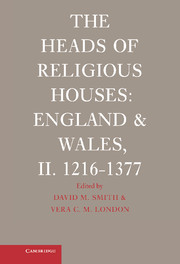Book contents
- Frontmatter
- Contents
- Preface
- Manuscript Sources Cited
- Printed Books and Articles Cited, with Abbreviated References
- Other Abbreviations
- Introduction
- HEADS OF RELIGIOUS HOUSES ENGLAND AND WALES II 1216–1377
- THE CLUNIAC HOUSES
- THE GRANDMONTINE HOUSES
- THE CISTERCIAN HOUSES
- THE CARTHUSIAN MONKS
- THE AUGUSTINIAN CANONS
- THE PREMONSTRATENSIAN CANONS
- THE GILBERTINE CANONS AND NUNS
- THE TRINITARIAN HOUSES
- MONASTERIES OF BONHOMMES
- UNIDENTIFIED ORDER AND HOUSE OF UNCERTAIN STATUS
- THE NUNS
- Index of Heads
- Index of Religious Houses
Introduction
Published online by Cambridge University Press: 28 January 2010
- Frontmatter
- Contents
- Preface
- Manuscript Sources Cited
- Printed Books and Articles Cited, with Abbreviated References
- Other Abbreviations
- Introduction
- HEADS OF RELIGIOUS HOUSES ENGLAND AND WALES II 1216–1377
- THE CLUNIAC HOUSES
- THE GRANDMONTINE HOUSES
- THE CISTERCIAN HOUSES
- THE CARTHUSIAN MONKS
- THE AUGUSTINIAN CANONS
- THE PREMONSTRATENSIAN CANONS
- THE GILBERTINE CANONS AND NUNS
- THE TRINITARIAN HOUSES
- MONASTERIES OF BONHOMMES
- UNIDENTIFIED ORDER AND HOUSE OF UNCERTAIN STATUS
- THE NUNS
- Index of Heads
- Index of Religious Houses
Summary
The purpose and scope
This book aims at providing lists of all known superiors of the religious houses in England and Wales between 1216 and 1377. Like the previous volume, covering the years 940–1216, we have restricted our interpretation of religious house to cover all establishments of monks, regular canons, and nuns, whether of abbatial or lower rank and whether autonomous or dependent. These lists are based on houses in existence between 1216 and 1377 as recorded in the relevant sections of Medieval Religious Houses, England and Wales. A few small houses have failed to reveal the names of any heads and we have intentionally omitted hospitals, colleges, the military orders, and for this period the mendicant orders who arrived in England in the thirteenth century. The decision to omit the last-mentioned was taken partly because of the work that is presently being done on biographical registers of the mendicant friars by such scholars as Dr Michael Robson (Franciscans in England and Wales) and Fr Richard Copsey (Carmelites in England, Scotland and Wales) and the as yet unused research material left by the late Dr A. B. Emden (in the Modern Papers Department of the Bodleian Library, Oxford).
The materials
The one great advantage for compilers of the 1216–1377 volume over the earlier volume, which is at the same time daunting and overwhelming, is the development of record-keeping in the thirteenth century and the consequent great growth of surviving material – both the new series of records and the bulkier continuations of earlier extant series.
- Type
- Chapter
- Information
- The Heads of Religious HousesEngland and Wales, II. 1216–1377, pp. 1 - 12Publisher: Cambridge University PressPrint publication year: 2001



